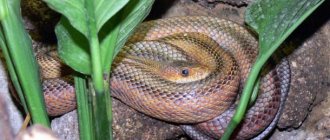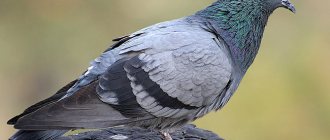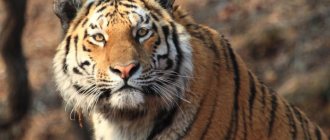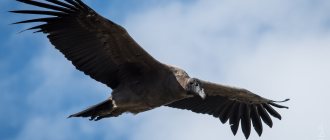Identifying the record-breaking snake is not so easy, because... In captivity it is impossible to measure the size of a snake. There are many stories about reptiles caught in various forests that were of gigantic size, but there is no documentary evidence.
The largest snakes on the planet were recognized as an extinct species, Titanoboa, which were most likely related to the boa constrictor. They lived on the territory of modern Colombia about 60 million years ago. Zoologists, having analyzed her skeleton, decided that she weighed more than a ton and could reach 15 m in length.
The modern record holder for length is the reticulated python. The largest snake that lived in captivity is Samantha, her length is 7.5 m, she was a female reticulated python. It could be seen at the Bronx Zoo, and the record-breaking snake was caught in Borneo; it lived until 2002.
We present to you a list with photographs of the 10 longest snakes in the world: individuals listed in the Guinness Book of Records.
Top 10 largest snakes on the planet
Snakes are measured by length and weight. Why do you need to catch a reptile? But if we are talking about giants, then catching them is not an easy task. In addition, there are likely to be longer relatives of the record holder in the forests and steppes of the planet. Therefore, the average size of a snake only indicates that 50% of the population reaches the specified length.
Top 10 longest species:
- reticulated python (Malayopython reticulatus) – 7.9 m;
- hieroglyphic python, or African rock python (Python sebae) – 7.5 m;
- amethyst python (Simalia amethistina) – 7.2 m;
- Burmese python (Python bivittatus) – 5.74 m;
- green anaconda (Eunectes murinus) – 5.6 m;
- Cuban boa constrictor (Chilabothrus angulifer) – 4.8 m;
- tiger python (Python molurus) – 4.6 m;
- Paraguayan anaconda (Eunectes notaeus) – 4.6 m;
- large water python (Apodora papuana) – 4.39 m;
- common boa constrictor (Boa constrictor) – 4.3 m.
Black mamba, up to 4 m
A common poisonous snake in Africa is the black mamba , which prefers to crawl on the ground, only occasionally climbing trees. It is dark olive or grayish-brown in color, but the inner cavity of the mouth is black, which is how it got its name. It is considered very dangerous; previously, encountering it always resulted in death, but then an antidote was invented. In addition, the snake is very aggressive and easily excited; after a bite, a person can die within 45 minutes.
Its length is 2.5 - 3 m, but some specimens reach up to 4.3 m. But there is no documented information yet that it can reach such sizes. With this length, it weighs about 1.6 kg, because... is slim.
Another feature of it is its speed of movement; at short distances it is 16-19 km/h, but it is officially confirmed that it reached speeds of up to 11 km/h.
Reticulated python
The largest snake in the world, based on body length, is the reticulated python, so called due to the complex mesh pattern on its skin. A flattened head, a light zigzag pattern on the sides surrounded by brown scales are the distinctive features of the reptile.
The longest representative of this species in history is the female Samantha (7.5 m), who lived in the New York Zoo. Old lady Samantha died in 2002 for an unknown reason. The title of longest snake went to the python Fluffy (7.3 m). But the Guinness Book of Records considers the record holder to be an unnamed representative of this family of reptiles, caught in 1912 on the island of Sulawesi in Indonesia. The length of the giant is 9.75 m.
View this post on Instagram
A post shared by Victor Ray (@v1cr4v)
The size of pythons at all times depends on the size of potential prey. Therefore, the record holder is quite capable of reaching 10 m. In 1931, Sumatran planter Boris Hembree described in his book a killed python measuring 10.2 m.
The reticulated python is an adaptable snake. It is found everywhere in Southeast Asia - from lowlands to foothills. It prefers to hunt in bushes and the edges of mangroves, which become home to small mammals and reptiles. Weighs up to 75 kg.
In cities, reticulated pythons swim into drainage canals. They hunt cats and rats. There are proven cases where giants attacked and ate people.
Origin of the species and description
Photo: Reticulated Python
The reticulated python was first described in 1801 by the German naturalist I. Gottlob. The species name "reticulatus" is Latin for "reticulated" and is a reference to the complex color scheme. The common name Python was proposed by the French naturalist F. Daudin in 1803.
In a genetic DNA study conducted in 2004, it was discovered that the reticulated python is closer to the water python, and not to the tiger python, as previously thought. In 2008, Leslie Rawlings and colleagues reanalyzed the morphological data and, combining it with genetic materials, found that the reticulated genus is an offshoot of the lineage of aquatic pythons.
Video: Reticulated Python
Based on molecular genetic studies, the reticulated python has been officially listed since 2014 under the scientific name Malayopython reticulans.
Within this type, three subspecies can be distinguished:
- malayopython reticulans reticulans, which is a nominotypic taxon;
- malayopython reticulans saputrai, which is native to parts of the Indonesian island of Sulawesi and Selayar Island;
- malayopython reticulans jampeanus is found only on Jampea Island.
The existence of subspecies can be explained by the fact that the reticulated python is distributed over fairly large areas and is found on separate islands. These snake populations are isolated and there is no genetic mixing with others. A possible fourth subspecies is currently being investigated, which is found on Sangihe Island.
African rock python
The rock python is the largest snake in Africa, reaching a size of 6-7 m. But snakes not exceeding 3-3.5 m are more common.
View this post on Instagram
A post shared by Victor Ray (@v1cr4v)
It lives in the lowlands and small forests of southeast Asia. The python swims quickly and easily climbs trees. It is non-venomous, so it kills the victim by squeezing it in rings. Often eats animals the size of an antelope or African crocodile. Doesn't attack people.
What does it eat in the wild?
These snakes often feed on large or small mammals, depending on the age and size of the python itself, as well as birds.
It can be:
- monkey;
- rabbits;
- lizards;
- birds;
- rodents, such as mice and rats;
- antelope;
- wild pigs;
- other snakes.
Shedding
Young pythons shed frequently, every 2-4 weeks. Adults can molt every few months. The skin begins to peel off from the head, and then peels off from the entire torso. Signs include clouding of the python's eyes and skin. During molting, the snake does not eat anything, and it becomes more excitable.
Amethyst Python
It is a non-venomous snake from the Pythonidae family. Found in Indonesia, Guinea and Australia. According to unverified reports, it reaches a size of 8 m. However, herpetologists have not been able to find a single amethyst python longer than 6 m.
View this post on Instagram
A post shared by Victor Ray (@v1cr4v)
Only in 1990, scientists conducted a study of snakes on the island of Biak in Indonesia, where they caught a female 7.2 m long, which is considered the official record for these reptiles.
Burmese python
The large reptile with beautiful skin pattern and calm nature is known as the longest pet. Over 30% of “python lovers” purchase Burmese pythons. Unfortunately, people do not take good care of reptiles. When a pet grows up, it is often released into the “wild” urban environment.
Burmese pythons have spread throughout the jungles of Southeast Asia. Young reptiles spend most of their time in trees to escape predators. With age, body weight forces the python to switch to terrestrial living.
View this post on Instagram
A post shared by Victor Ray (@v1cr4v)
The record for the length of a Burmese python was set by a female from the Snake Safari Zoo, located in the suburbs of Chicago. The python has grown to 5.74 m. Some reports mention longer reptiles, but this is unconfirmed information. Scientists measured the "Burmese" to be only 4.5–5 m long.
Green anaconda
The inhabitant of the Amazon forests and the Orinoco River reaches 8.8 m, according to unconfirmed reports. Typical adult anacondas grow to 5 m (males) and 4.5 m (females). Even with its confirmed size, the anaconda is America's largest snake.
View this post on Instagram
A post shared by Victor Ray (@v1cr4v)
Having lost the title to the longest one, the anaconda remains the leader in mass. The weight in the snake is on average 97.5 kg. Scientists arrived at this figure by measuring 780 anacondas caught from 1992 to 1998. According to unverified information, record-breaking anacondas reach a weight of 227 kg.
Cuban boa constrictor
This is the largest snake living in Cuba and the islands closest to it. The length of the boa constrictor is 4.8 m. Recently, the reptile is rare due to the fact that Cuban farmers exterminate the boa constrictor for meat and fat, which is also used for food. Boas are also caught for sale as pets to lovers of large reptiles.
View this post on Instagram
A post shared by Victor Ray (@v1cr4v)
The Cuban boa constrictor's calm attitude towards people makes it easy to study. In May 2022, the University of Tennessee published a study on the characteristics of boa hunting.
If you remember the boa constrictor Kaa from the famous cartoon, he hunted in splendid isolation. But scientists from the United States were able to document the coordinated hunting of bats by Cuban boa constrictors. The snakes created a living fence of several reptiles across the flight path of the prey. The opening was not counted (yet). Opponents point out that hunting 9 boa constrictors in one place does not mean joint hunting.
Diamondback rattlesnake
This is a large and thick reptile that is considered the heavyweight champion among venomous snakes. The body size of record-breaking rattlers ranges from 1.8 to 2.4 m. Weight reaches 15 kg. But the majority are diamondback rattlers, 1.5–1.8 m long and weighing 56.5–56.8 kg.
View this post on Instagram
A post shared by Victor Ray (@v1cr4v)
Lives in the southeastern United States. Prefers coastal forests, places where shrubs accumulate, and damp areas of soil. Does not strive for frequent swimming, but overcomes rivers and small lakes.
Reproduction
Pythons are ready to breed when they reach 5-6 years of age. It occurs from the beginning of autumn to the end of winter. With the help of pheromones, the female communicates her readiness to reproduce. The male finds her by smell.
After mating, after 80-90 days, the female lays approximately 100 eggs, but more often there are no more than 60. At this moment, the snake’s body temperature rises by 12-15 degrees. They guard the clutch and do not eat anything.
After 2-3 months, the cubs appear, ranging in length from 17 to 70 cm.
What is the name of the largest snake on the planet?
In some Internet sources, since 2010, there has been a message about the largest snake on the planet, which Egyptian biologists caught in the Red Sea. The name of the giant is Maga Maar Malad. Age – 103 years. Length – 30 m. Weight – several tons.
This message is a classic example of clickjacking. A scam in which the user is asked to go to a page to watch an amazing video. Before the video opens, the visitor needs to share it on social networks. Along with the browsing, malicious software gets onto the computer, giving the fraudster access to the computer and personal data, including accounts. Clicking the “Share” button sends the malicious file to the curious user’s friends.
By the way, for the first time information about the giant appeared on a bulletin board for students from Vietnam. Alas, giant snakes exist only in Hollywood cinema.
Reports of giant snakes appear in the press regularly. But it is difficult to estimate the size of a reptile from a distance. Therefore, people are sometimes mistaken, and sometimes they experience the hunter’s desire to show his best side and show off his gigantic prey.
Extinct giants
Titanoboa cerrejonensis is an extinct snake whose fossils were discovered in the Cerrejon coal mine in Colombia. Lived on Earth millions of years after the extinction of dinosaurs. The largest snake in the world looked like a modern boa constrictor, but hunted like an anaconda.
View this post on Instagram
A post shared by Victor Ray (@v1cr4v)
Pictured is a sculpture of Titanoboa.
A fossil spine discovered in a mine shows that its owner reached a length of 13-15 m. Jason Head's team from the University of Toronto studied the vertebrae of 8 individuals and found that they were the same size, which means that the terrible reptiles had a similar food base and similar length. Titanoboa weighs 1.3 tons. The ancient snake is 30 times heavier than the anaconda, the record holder for weight among snakes of the 21st century.
Snakes are cold-blooded. Head's team calculated that temperatures in past rainforests would have had to be between 32 and 33°C to support the giant's metabolism. This is almost 2 times higher than modern temperatures. Titanoboa's prey found in fossils was larger, with fish 3 times the size of today's Amazon inhabitants and a turtle the size of a desk.
Gyurza
This representative of giant vipers does not have the most impressive dimensions. It can grow up to 2 meters in length, and its weight does not exceed 3 kg. But this does not prevent her from being one of the most dangerous to humans. Gyurza has a lightning-fast reaction and an incredible ability to rush at his target, covering a distance of 2 meters in one jump. Even experienced snake catchers sometimes cannot cope with this poisonous beast, since it is quite difficult to hold its muscular body in your hands.
The distribution area of the viper is extensive; it can be found in the countries of the former Soviet Union, in many Asian countries, on the African continent and some other places.











